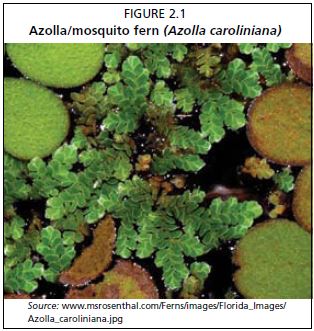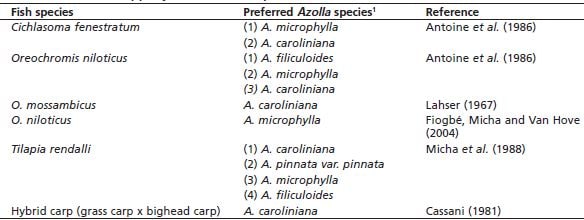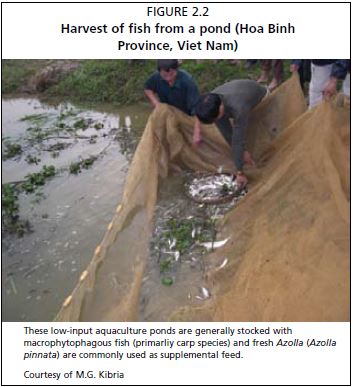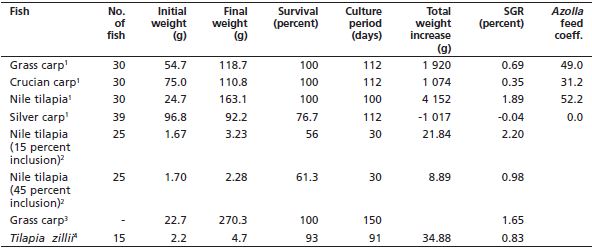2.5. Use as aquafeed
In spite of its attractive nutritional qualities and relative ease of production in ponds and rice-fields, reports on the use of Azolla in aquaculture are extremely limited. The value of Azolla as a fish feed is still being studied. Available literature on the use of Azolla for this purpose has been reviewed as follows under the headings experimental studies and field studies.
2.5.1 Experimental studies
A few studies have been carried out in aquaria to examine the preference for various Azolla species by different cichlid species and a carp hybrid. These tests were carried out using fresh Azolla; the results are summarized in Table 2.3. These preference tests indicate that A. caroliniana (Figure 2.1) is one of the most preferred species for cichlids.
A number of growth studies have been carried
out to evaluate Azolla as fish feed under laboratory rearing conditions. Most of these studies were conducted on cichlids and little or no attempt was made to use Azolla as a feed for grass carp, a predominantly macrophytophagous feeder. In these studies, Azolla was fed either in fresh or dried powdered form as a whole feed or by partially replacing fishmeal in pelleted diets.
Almazan et al. (1986) conducted a study where A. pinnata was fed to Nile tilapia (Oreochromis niloticus) fingerlings and adult males. Fingerlings were fed Azolla in fresh, powder, and pellet form, replacing the complete control diet mix from 10 percent to 90 percent. The control diet consisted of 40 percent fishmeal, 40 percent rice bran, 10 percent cornstarch, 9 percent corn meal and 1 percent Afsillin (micronutrient premix). Negative
Figure 2.1
Azolla/mosquito fern (Azolla caroliniana)
Source: www.msrosenthal.com/Ferns/images/Florida_Images/ Azolla_caroliniana.jpg

Table 2.3
Preference of Azolla spp. by different fish species

1 Azolla species are arranged chronologically for each fish species in order of preference i.e. from most preferred to less preferred
or very slow growth was obtained in all Azolla-incorporated diets. A lowering of growth performance and FCRs was observed with increasing Azolla incorporation. Adult male tilapia were fed dried Azolla pellets or fresh Azolla ad libitum. Despite feeding to satiation, tilapia suffered weight loss in a 30-day feeding trial. The experiments were carried out in aquaria. Similarly, Antoine et al. (1986) working with O. niloticus and Cichlasoma melanurum and Micha et al. (1988) with O. niloticus and Tilapia rendalli reported poor growth and feed utilization when they were fed A. microphylla-based diets. Antoine et al. (1986) and Micha et al. (1988) conducted a 70-day growth trial and fed the target species with three different diets: commercial pellets (34 percent protein); fresh Azolla plus 28 percent protein commercial pellets (50:50); and fresh Azolla
(22 percent protein).
In other studies, El-Sayed (1992; 2008) reported extremely poor performance for O. niloticus fingerlings and adults fed diet based on A. pinnata. This author incorporated dried Azolla powder at 25, 50, 75 and 100 percent replacement of fishmeal protein in a fishmeal-based control diet in a 70-day trial. Fresh Azolla as a total diet was also used as a control. Growth and feed utilization efficiency of fish fed with the control diet was significantly higher compared to fish fed with Azolla-supplemented diets. The performance of fish was inversely related to the increasing dietary incorporation of Azolla. In fish fed with the total Azolla (dry/fresh) based diet, the reduction was extremely sharp. Fresh Azolla-fed adults started losing weight from the 7th week. Fish fed with fresh plant material had significantly higher moisture content than fish fed with formulated diets. Body protein and lipid levels were negatively correlated with the concentrations of Azolla in the diets; ash content showed a positive correlation.
In all the experimental studies examined above (Almazan et al., 1986; Antoine et al., 1986; Micha et al., 1988), fish growth was higher in the conventional control diets than in the Azolla-based diets. Fish died or negative growth was recorded when fed exclusively with fresh Azolla.
In apparent contrast, Santiago et al. (1988) found that O. niloticus fry fed rations containing up to 42 percent of A. pinnata outperformed fish fed a fishmeal-based control diet. Growth and feed utilization of O. niloticus fry improved with increased dietary inclusion of Azolla and the survival was unaffected. These results differed from the studies of Almazan et al. (1986), Antoine et al. (1986) and Micha et al. (1988) and it must be pointed out that Santiago et al. (1988) used a 35 percent protein diet with early fry (11-14 mg). In the other studies, the crude protein level was generally lower and the studies were carried out with advanced fry, fingerling or adults. El-Sayed (2008) noted that young Nile tilapia utilized Azolla more efficiently than adults.
Fiogbe, Micha and Van Hove (2004) obtained quite favourable results with Azolla-based diets fed to juvenile Oreochromis niloticus grown in a recirculating system. Six diets were formulated with almost isonitrogenous levels of protein (27.25-27.52 percent DM) but different levels of dry Azolla meal (0, 15, 20, 30, 40 and 45 percent). All diets with incorporated Azolla meal showed weight gain. The Azolla-free diet and the diet containing 15 percent Azolla produced the same growth performance. The least expensive diet, which contained 45 percent Azolla, also showed growth and was thought to be potentially useful as a complementary diet for tilapia raised in fertilized ponds. These authors noted that mixing Azolla with some agricultural by-products such as rice bran; the use of fermentable by-products such as yeasts; or the addition of purified enzymes; might improve ingestion and digestibility.
Carcass compositions of fish were reported to be markedly affected by feeding with Azolla. Antoine et al. (1986) observed that when fed with fresh Azolla, both O. niloticus and C. melanurum had higher moisture and lower lipid concentrations. Similar results and an increase in carcass ash content for O. niloticus and T. rendalli
were reported by Micha et al. (1988). El-Sayed (1992) also made similar observations when he fed fresh and dried A. pinnata to O. niloticus. However, his observation differs from the previous authors to the extent that carcass protein content was negatively correlated with Azolla levels in the diets, while the other workers recorded no effect on carcass protein content.
The poor growth of fish fed with diets containing higher levels of Azolla may be due to excesses or deficiencies of amino acids, according to Fiogbe, Micha and Van Hove (2004). Cole and Van Lunen (1994) found that inadequate levels of essential amino acids resulted in depression of food intake and growth. Deficiencies of one or more amino acids are known to limit protein synthesis, growth or both.
2.5.2 Field studies
Until recently, reports of on-farm utilization of Azolla were limited (Cagauan and Pullin, 1991). At that time reports came only from China and Vietnam (Figure 2.2). More recently Azolla has increasingly been used as feed and/or fertilizer in studies with rice-fish culture systems in many other Asian countries. Reddy et al. (2005) reported that the manuring schedule can be reduced by 30-35 percent through Anabaena azollae —Azolla biofertilization in aquacultural ponds.
Azolla in cage culture
Pantastico, Baldia and Reyes (1986) used fresh whole A. pinnata as a supplemental feed for the cage culture of Nile tilapia in Laguna de Bay, Philippines. Azolla was propagated in fine mesh net enclosures in the lake and harvested for feeding to tilapia in cages. Four separate experiments were conducted and weight gain was compared with an unfed control. It was assumed that in control cages fish grew by feeding natural food (i.e. plankton) available in the cage. A summary of the results is given in Table 2.4. Although higher weight gain of fish was observed over the unfed control, the difference in mean weight between fish fed fresh Azolla and unfed control was about 5-10 g. The results of this cage culture study do not justify fish culture in cages using Azolla as the only feed.
Figure 2.2
Harvest of fish from a pond (Hoa Binh Province, Viet Nam)

These low-input aquaculture ponds are generally stocked with macrophytophagous fish (primarliy carp species) and fresh Azolla (Azolla pinnata) are commonly used as supplemental feed.
Courtesy of M.G. Kibria
Table 2.4
Cage culture of Nile tilapia using Azolla as feed

Rice-fish-Azolla integration
One of the most successful uses of Azolla is its use as fertilizer and/or feed in an integrated rice-fish-Azolla system. This system is based on convenient layout of the fields, which allows the simultaneous development of rice, Azolla and different fish with complementary nutritional requirements (Van Hove, 1989). In this ecological agricultural layout, each of the partners contributes to the equilibrium of the system. The fish (a correct mixture of planktophages, macrophytophages and polypages) derive a benefit from Azolla - more or less, depending on the species; their waste promotes the proliferation of plankton that is consumed by some of the fish and fertilizes the rice. The polyphagous fish protect the rice and Azolla from a number of insects and molluscan pests.
Cagauan and Pullin (1991) reviewed the rice-fish-Azolla integrated system and described its physical set-up, which is provided with pits (pond refuse/ main channel) and ditches (trenches). Lateral or peripheral trenches are interconnected with each other and with the main channel. Trenches serve as links for the fish from the main channel to rice field area and also as a growing area for Azolla during the paddy cultivation period. Depending on the size of the rice field, trenches may be dug at 15-20 m intervals in single or rib-shaped patterns. In India, a 0.2 ha rice field was provided with 0.5 m deep and 0.5 m wide trenches and a 1.0 m deep and 1.5 m wide main channel (Shanmugasundaram and Ravi, 1992). Cagauan (1994) used 1 m wide and 0.75 m deep pond refuge connected to an outer trench that was 0.3-0.4 m wide and 0.2-0.3 m deep in a 200 m2 paddy field. The trenches and main channels should occupy about 10-15 percent of the rice field area (Cagauan and Pullin, 1991; Shanmugasundaram and Balusamy, 1993). Inoculation of the rice field with Azolla at the rate of 4.5-6.0 tonnes/ha is done 20 days before rice transplanting. Propagated Azolla biomass is ploughed under, together with inorganic fertilizer, before rice transplanting. The field is then reflooded to allow the Azolla that floated during the incorporation to grow and serve as a fish fodder. In case of insufficiency of Azolla in the channels and trenches, additional supplemental feed is given. The fish species cultured in these rice fish-Azolla systems are mainly Nile tilapia. Other species are common carp, Indian major carp, Java barb, etc. Grass carp may not be a suitable species for this system, as they may damage the rice crop by feeding on its leaves.
The use of Azolla (A. microphylla) as a fertilizer in rice-fish farming was studied by Cagauan and Nerona (1986) and Cagauan (1994). Cagauan and Nerona (1986) used three fertilizer regimes: Azolla only; inorganic fertilizers (urea and ammonium phosphate) only; and Azolla plus inorganic fertilizers for rice-fish culture with Nile tilapia as the target species. When a combination of Azolla and inorganic fertilizers was used, it was possible to reduce the standard rate of inorganic fertilizers by half. Fish yields were the same with Azolla or inorganic fertilizers alone, whereas the yields of both fish and rice were higher in the combined Azolla and inorganic fertilizer regime (Table 2.5).
Shanmugasundaram and Ravi (1992) reported the use of Azolla (A. microphylla) as nitrogen fixing fertilizer and feed for Nile tilapia (O. niloticus) stocked in a low-lying ricefield (0.2 ha) in the Tanjore Deltaic Zone, Tamil Nadu, India. The ricefield was
Table 2.5
Use of A. microphylla as fertilizer in rice-fish culture system- fish species (O. niloticus)

Source: Cagauan and Nerona (1986)
provided with trenches and connected to a main channel and the fish were raised in these trenches. The stocking density used was 6 000/ha for fingerlings weighing 19 g. Both fresh and dried Azolla were fed. Dried Azolla was incorporated in a supplemental fish feed and applied at 5 percent BW/day. The formula of this supplemental feed was stated to be Azolla (50 percent), rice bran (15 percent), chicken manure (10 percent), corn meal (5 percent), sorghum meal (5 percent), broken rice (2.5 percent) and groundnut cake (2.5 percent). The provision of water space for the fish lowers rice yields by about 300 kg/ha but the fish harvest compensates. Rice and fish culture yields a net income of US$258/crop/ha, compared to US$207/crop/ha for rice alone.
Furthermore, Shanmugasundaram and Balusamy (1993) reported the use of Azolla (A. microphylla) as feed to raise Indian major carps (catla, rohu and mrigal) stocked in low-lying wetlands in Bhavanisagar, Tamil Nadu, India. These authors used a 0.25 ha ricefield provided with trenches (1.0 m depth and width) to shelter the fish. Stocking density was 3 000/ha, using a 1:1:1 ratio of catla, rohu and mrigal. Azolla was applied twice at 2.0 tonnes/ha. Supplemental feed containing banana pseudostem and cow dung (1:1) was fed along with rice bran at 5 percent BW/ per day. Banana pseudostem and cow dung were incubated overnight before mixing with rice bran. Both rice and fish yields increased, with higher benefit cost ratios (1.88) in rice-fish-Azolla
Table 2.6
Economics of rice-fish-Azolla integration in India

integration than rice-fish cultivation (1.57) (Table 2.6). Similarly, substantial increases in fish yield in rice-fish culture with Azolla compared to rice-fish without Azolla have been reported by Cagauan and Pullin (1991). Fish yields from rice-Azolla-fish culture trials were higher than those for rice-fish culture (Table 2.7). Yields from Nile tilapia in monoculture and from polyculture of common carp, grass carp and Nile tilapia were 1.20 and 1.06 tonnes/ha/year respectively from a rice-fish-Azolla system, compared with 0.63 and 0.70 tonnes/ha/year respectively from rice-fish fields without Azolla.
In rice farming systems, including rice-fish culture, Azolla is best incorporated as a fertilizer during its linear growth phase, when there is maximum productivity, low lignin content and therefore rapid decomposition. The value of Azolla as a fish feed is also highest during its linear growth phase. The crude protein content of Azolla
is generally higher during this phase. The amino acid content of Azolla increases during the linear growth phase and falls sharply when the growth slows down with a corresponding increase in its lignin content. Digestibility clearly decreases after the linear growth phase with increasing lignin content (Van Hove et al., 1987). It is therefore important to maintain an equilibrium between the population of fish and that of Azolla, either by introducing, when necessary, a supplementary biomass of Azolla
collected elsewhere, or by harvesting the excess biomass in order to keep the Azolla population in the linear growth phase.
Pig-duck-fish-Azolla and fish-Azolla integration
Very few reports are available on the use of Azolla as fish feed in pond culture; however, there are reports of integrated studies. Majhi, Das and Mandal (2006) fed grass carp (Ctenopharyngodon idella) fingerlings with finely chopped Azolla caroliniana placed over a feeding basket under pond conditions. Azolla was well accepted by grass carp. The final weight gain of Azolla-fed fish was significantly higher compared to the control fish. The net profit for production of grass carp was US$0.12/m2.
Gavina (1994) studied pig-duck-fish-Azolla integration. Nile tilapia were stocked in three earthen ponds with a uniform water depth of 50 cm. The ponds were fertilized with a mixture of dry pig and duck manure at the rate of 500 kg/ha. After initial manure application, the water level was increased to 80 cm in all three experimental ponds. The ponds were stocked at three densities: 10 000/ha; 20 000/ha; and 30 000/ha. All treatments were manured (pigs and ducks) with 100 kg fresh material/ha/day and supplemented with fresh Azolla at 200 g/m2/week. The consumption of Azolla by fish was not monitored. However, it was observed that the fresh Azolla were seeded at a
Table 2.8
Weight gain comparisons of Azolla-fed fish

1 modified from FAO (1988 cited by Cagauan and Pullin, 1991)
2 Fiogbe, Micha and Van Hove (2004)
3 Majhi, Das and Mandal (2006)
4 Abdel-Tawwab (2008)
Floating aquatic macrophytes – Azolla 27
rate of 200 g/m2/week (10 kg/50 m2) and cleared by fish after 6 or 7 days. It was found that Azolla could be a viable source of supplementary feed, considering the high cost of commercial feeds. The study was conducted for a period of three months. Mean net yield varied between 8.22 and 10.97 kg/ha/day (3-4 tonnes/ha/year) at stocking densities ranging between 10-30 000/ha.
Weight gain comparisons of Azolla-fed fish were carried out by the Soil and Fertilizer Institute of the Hunan Academy of Agricultural Sciences (FAO, 1988 cited by Cagauan and Pullin, 1991) using grass carp, Nile tilapia, crucian carp (Carassius auratus) and silver carp (Hypopthalmychthys molitrix) (Table 2.8). The weight gain by Azolla-fed grass carp averaged 174 g/fish compared with 134 g/fish for Nile tilapia and 35.8 g/fish for crucian carp. A weight decrease of 4.6 g/fish was observed for silver carp.